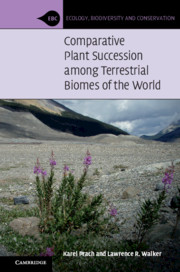Book contents
- Comparative Plant Succession among Terrestrial Biomes of the World
- Ecology, Biodiversity, and Conservation
- Comparative Plant Succession among Terrestrial Biomes of the World
- Copyright page
- Contents
- Preface
- 1 Introduction
- Part I Plant Succession and Biomes
- Part II Succession by Disturbance Type
- 4 Comparative Approach
- 5 Volcanoes
- 6 Glaciers
- 7 Cyclones
- 8 Dunes
- 9 Landslides
- 10 Floods
- 11 Fire
- 12 Clearcuts
- 13 Plowed Fields
- 14 Mines
- 15 Other Disturbances
- Part III Synthesis
- Book part
- References
- Index
7 - Cyclones
from Part II - Succession by Disturbance Type
Published online by Cambridge University Press: 08 May 2020
- Comparative Plant Succession among Terrestrial Biomes of the World
- Ecology, Biodiversity, and Conservation
- Comparative Plant Succession among Terrestrial Biomes of the World
- Copyright page
- Contents
- Preface
- 1 Introduction
- Part I Plant Succession and Biomes
- Part II Succession by Disturbance Type
- 4 Comparative Approach
- 5 Volcanoes
- 6 Glaciers
- 7 Cyclones
- 8 Dunes
- 9 Landslides
- 10 Floods
- 11 Fire
- 12 Clearcuts
- 13 Plowed Fields
- 14 Mines
- 15 Other Disturbances
- Part III Synthesis
- Book part
- References
- Index
Summary
Cyclones (also called hurricanes or typhoons) are the first of two types of wind-caused disturbance that we discuss. The second category is dunes, covered in Chapter 8. Cyclones damage forests and infrastructure such as buildings, utility poles, and marinas. Cyclones can also be deadly, particularly in low-lying countries such as Bangladesh, which has lost hundreds of thousands of people to cyclones (Berz, 1988). They are also frequently accompanied by heavy rains, which can trigger flooding and landslides. Cyclones are primarily a disturbance of tropical climates but can also be found in temperate regions; they are most common in the Pacific Ocean, followed by the Indian and Atlantic Oceans (Plate 13).
- Type
- Chapter
- Information
- Publisher: Cambridge University PressPrint publication year: 2020

